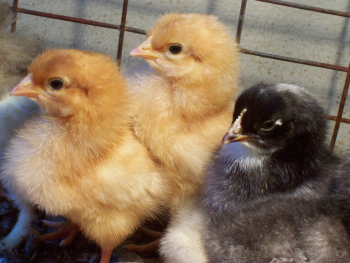
20090607chickens
 Dennis wrote to give us a
rundown on his most recent broiler chicken operation. I'm
reproducing his entire email below because I think it's worth reading,
but I've inserted a cut for those with limited patience.
Dennis wrote to give us a
rundown on his most recent broiler chicken operation. I'm
reproducing his entire email below because I think it's worth reading,
but I've inserted a cut for those with limited patience.
Raising
chickens for meat is emotionally different from raising them for
egg production. The chicks are just as cute when delivered but,
at
least in my case, I don't identify the birds individually or make any
attempt to observe their habits or individual characteristics.
Chicken
TV is great to watch with your layers and breeding stock but the birds
that we raise for meat are kept in a chicken tractor with little
opportunity to get out and perform. It is just as well, though,
because they are short lived with our normal processing day following
about 8 weeks after delivery.
My most recent batch of broilers started in late March with 26 birds. On Saturday [May 24] we processed the 17 that survived to the processing stage. It wasn't the fault of the supplier or even problems on pasture. We managed to lose the first 8 while still in the brooder when they piled in a corner because of our failure to properly monitor the heat levels. The other fatality occurred on pasture for no apparent reason, which happens from time to time.
We have
most recently been purchasing birds specifically bred for
growing on pasture. We were very happy with mortality rates and
with
the feed to meat ratio. Unfortunately, our supplier went
out of
business which forced us to make a change. This time we bought
birds
that appeared to have some of the same characteristics as those we had
been purchasing. In the past we had tried Cornish Rock Cross and
were
unhappy with the fat levels and with both the leg problems and
mortality
issues. The birds we bought this time did fairly well as far as
fat
levels and general health, but did not grow as quickly as any of the
breeds we had tried earlier.
I was
looking forward to processing day this batch a little more than
usual. My chicken raising partner told me that he had access to
an
automated chicken plucker and I was really looking forward to comparing
the speed, efficiency and level of mess to our normal method of
skinning
the chickens. As luck would have it, though, a few days before
processing I learned that the plucker was not available to us and we
were to conduct our normal process.
The
slaughter and processing of the birds is the phase of the entire
cycle which gives me the greatest connection between us and the life
that provides us with our meat. Our method of dispatching the
birds is
to place each one in a killing cone and to slice the carotid artery
with
a knife in one hand while holding the birds head in
our free hand. It is an intensely personal relationship with an
animal
to place it in a holding cone and then to perform the act which will
cause its death and then to hold its head while the blood,and with it,
the life, leaves its body.
We use a method to skin the birds which begins with the bird hanging in the air by its neck. A small incision is made in the skin beneath the feathers and the skin, along with the feathers is removed from the bird. A quick slice of the top rib on each side allows us to pull the breast free from the bird and gain access to the body cavity for easy removal of the internal organs. Thereafter, only a couple of quick cuts are necessary to remove wing tips, the feet and the head. The chicken can be further cut up or left as is. I like to cut the thighs off the carcass and the wings off the breast but that's a matter of choice.
The
drawback to skinning the chickens and our method of processing is
that there are no birds available for roasting or baking whole.
But, as
a practical matter, in my entire adult life I don't think my family has
prepared more than one or two chickens in that manner. So, we
don't
really lose any options that matter. Your mileage may vary.
Want more in-depth information? Browse through our books.
Or explore more posts by date or by subject.
About us: Anna Hess and Mark Hamilton spent over a decade living self-sufficiently in the mountains of Virginia before moving north to start over from scratch in the foothills of Ohio. They've experimented with permaculture, no-till gardening, trailersteading, home-based microbusinesses and much more, writing about their adventures in both blogs and books.
Want to be notified when new comments are posted on this page? Click on the RSS button after you add a comment to subscribe to the comment feed, or simply check the box beside "email replies to me" while writing your comment.
